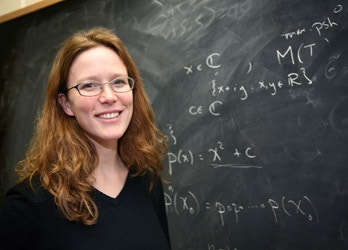MPS Awardee Spotlight: Laura DeMarco
Laura DeMarco is a 2015 Simons Fellow in Mathematics and a professor of mathematics at Northwestern University. Her research focuses on dynamical systems and complex analysis. She received her bachelor’s degree in mathematics and physics from the University of Virginia, her master’s degree in mathematics from the University of California, Berkeley, and her doctorate in mathematics from Harvard University.

For the past 15 years, DeMarco has explored the concepts of stability and bifurcation. “Throughout my mathematical career, I have been studying various aspects of stability in particular complex dynamical systems,” she says. “To say that a system is stable means that under perturbation it behaves the same. So, for example, if you push on something, will it fall over or will it rock back into place? If it rocks back into place, then it is stable, and if it falls over after you push it a little bit, then it is unstable. In any kind of dynamical system, whether in real life or just in a toy model, stability is a fundamental property.”
DeMarco is interested in forging new connections between fields. “Even when you’re learning about things that are known, there’s always a new way to think about them,” she says. “That’s how research happens. For me, building bridges to other fields and connecting subjects that people didn’t know were related is one of the most rewarding experiences.”
Variation of Canonical Height
Torsion points on an elliptic curve, drawn with dynamical methods, illustrate the variation of canonical height in a family of elliptic curves. The density of the torsion points determines the Archimedean component of a height function. The title refers to a series of three articles in the 1990s by Joseph Silverman, "Variation of the Canonical Height on Elliptic Surfaces," the main theorems of which imply that this illustration is mathematically correct.
In her current research, she applies dynamical methods to prove statements in arithmetic geometry. “Previously, we would take tools from algebra and try to prove statements about dynamical systems,” she says. “Now I’m trying to go the other way. I am taking methods that I already know regarding stability and dynamical systems and using them to answer questions about geometry and arithmetic.”
DeMarco says, “There are certain things that I just love — when I’m reading a research article, studying the details of what someone else has done, the only way to really understand a proof is to reconstruct it, to work through it yourself, getting down and dirty with the details. But what’s magical is: As you’re doing that and really struggling to learn something new, you realize that your understanding of it is actually very different from anything anyone else has done.
“The mathematicians I most admire are the ones who are very broad in their vision of how all of these different areas of mathematics fit together. Realizing how to answer questions in different ways is exciting.”





